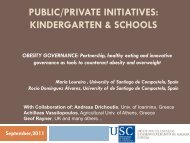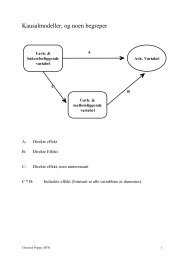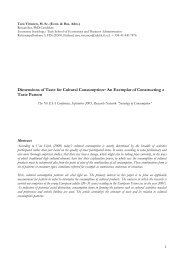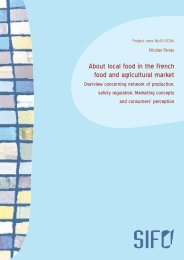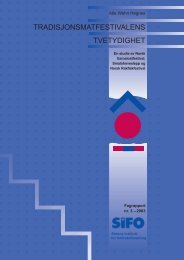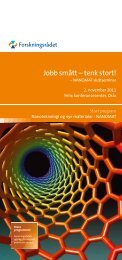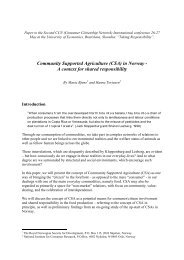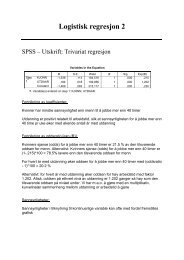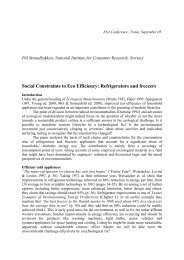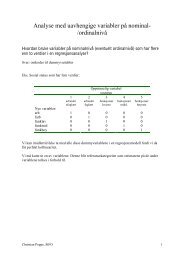an investigation of domestic laundry in europe - habits ... - SIFO
an investigation of domestic laundry in europe - habits ... - SIFO
an investigation of domestic laundry in europe - habits ... - SIFO
Create successful ePaper yourself
Turn your PDF publications into a flip-book with our unique Google optimized e-Paper software.
76An <strong><strong>in</strong>vestigation</strong> <strong>in</strong>to the <strong>domestic</strong> <strong>laundry</strong> <strong>habits</strong> <strong>in</strong> EuropeBacillusBacillus are <strong>an</strong>other common group <strong>of</strong> bacteria. Bacillus cereus is the pathogen<strong>in</strong> this group. It is not only known to cause food poison<strong>in</strong>g by produc<strong>in</strong>g atox<strong>in</strong> <strong>in</strong> cooked food; it c<strong>an</strong> also cause food borne <strong>in</strong>fection. Bacillus cereus isparticularly d<strong>an</strong>gerous because it is a spore-bear<strong>in</strong>g bacterium. A spore is arest<strong>in</strong>g body, which is produced when conditions are unfavourable for growth<strong>an</strong>d particularly when there is a lack <strong>of</strong> moisture. The spores c<strong>an</strong> survive <strong>in</strong> adorm<strong>an</strong>t condition for long periods <strong>of</strong> time under adverse conditions, butwhen suitable conditions <strong>of</strong> food, moisture <strong>an</strong>d temperature return they areable to germ<strong>in</strong>ate <strong>in</strong>to actively grow<strong>in</strong>g bacteria aga<strong>in</strong>. In the studies <strong>of</strong> F<strong>in</strong>ch[1] <strong>an</strong>d Speirs [2], Bacilli were found on soiled dishcloths, tea towels <strong>an</strong>dh<strong>an</strong>d towels. Betz [7] used a culture <strong>of</strong> Bacillus subtilis for his test.Staphylococcus aureusStaphylococcus aureus is reported as the most import<strong>an</strong>t cause <strong>of</strong> food poison<strong>in</strong>g.50% <strong>of</strong> all people carry this bacteria <strong>in</strong> their nose <strong>an</strong>d/or around the<strong>an</strong>us. Staphylococcus aureus is spread easily by contam<strong>in</strong>ated h<strong>an</strong>ds, utensilsetc. Aga<strong>in</strong>, F<strong>in</strong>ch [1] <strong>an</strong>d Speirs [2] found Staphylococcus aureus on soileddishcloths, tea towels <strong>an</strong>d h<strong>an</strong>d towels. Most <strong>of</strong> the work <strong>of</strong> Walter [6] <strong>an</strong>dpart <strong>of</strong> the studies by Scott [3] [ 4] were based on artificial contam<strong>in</strong>ation withStaphylococcus aureus.Yeasts <strong>an</strong>d FungiYeasts <strong>an</strong>d fungi are found everywhere. Spores c<strong>an</strong> survive dry conditions butfor the most part yeast <strong>an</strong>d fungi are found <strong>in</strong> damp conditions. Only Block[5] used a yeast culture <strong>in</strong> his study. Other studies focuss<strong>in</strong>g on yeasts <strong>an</strong>dfungi were not found.Total Plate CountThe Total Plate Count gives <strong>an</strong> idea <strong>of</strong> the overall effect <strong>of</strong> wash<strong>in</strong>g. There arem<strong>an</strong>y different bacteria present <strong>in</strong> <strong>laundry</strong>. Us<strong>in</strong>g Total Plate Count almostevery bacterium present <strong>in</strong> the <strong>laundry</strong> will be detected.4.3.3 Selection <strong>of</strong> Laundry ItemsIn order to f<strong>in</strong>d the selected micro-org<strong>an</strong>isms, <strong>laundry</strong> items have to be selected.In this experiment the hygienic condition <strong>of</strong> naturally soiled <strong>laundry</strong> is



